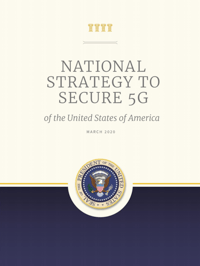 The 5G era is here. Soon carriers will begin offering 5G services to enable many new and exciting applications for this technology. The consumer applications for 5G are numerous; gaming, autonomous vehicles, video, commerce, tech-enabled medicine, retail, finance coupled with AI, ML, and AR/VR: all of these will provide a new level of user/customer experiences. This will be achieved by an ecosystem of telecommunications infrastructure, software and service providers in support of both existing and new forms of carriers and operators. The White House published the National Strategy to Secure 5G earlier this year and it is worth the time to read it in its entirety.
The 5G era is here. Soon carriers will begin offering 5G services to enable many new and exciting applications for this technology. The consumer applications for 5G are numerous; gaming, autonomous vehicles, video, commerce, tech-enabled medicine, retail, finance coupled with AI, ML, and AR/VR: all of these will provide a new level of user/customer experiences. This will be achieved by an ecosystem of telecommunications infrastructure, software and service providers in support of both existing and new forms of carriers and operators. The White House published the National Strategy to Secure 5G earlier this year and it is worth the time to read it in its entirety.
The ecosystem of players are working hard to define and build a resilient 5G infrastructure that meets the new speed and scale requirements, while also adopting new and open technologies that disaggregate hardware and software functions.
Disaggregation of the hardware and software functions opens up the wireless and telecommunications infrastructure and enables new vendors to access a broader set of service providers to develop and deploy 5G services that will deliver the connectivity, speed and data capacity that these new applications will consume.
The National Strategy to Secure 5G is as much an articulation of a vision for America to lead the development, deployment, and management of secure and reliable 5G communications infrastructure, as well as a call to action for the country - specifically the telecom industry as well as partners and allies - to address the challenges inherent with this new technology:
Here are just a couple of excerpts that have particular relevance for our community.
Private-sector and public-private engagements:
“Coordination and working with governmental agencies in a few areas around Assess the Risks Posed by Cyber Threats to and Vulnerabilities in 5G Infrastructure The United States Government, in partnership with State, local, and tribal governments as well as private sector partners, will seek to continuously identify and characterize economic, national security, and other risks posed by cyber threats to and vulnerabilities in 5G infrastructure.”
“Develop Security Principles for 5G Infrastructure in the United States The United States Government will work with the private sector to identify, develop, and apply core security principles - best practices in cybersecurity, supply chain risk management, and public safety - to United States 5G infrastructure. The principles will be synchronized with other security principles endorsed by the United States Government, such as the “Prague Proposals” from the Prague 5G Security Conference in May 2019.”
“Promote Responsible Global Development and Deployment of 5G Promote United States Leadership in International Standard Development and Adoption The United States Government will work to preserve and enhance United States leadership on 5G in relevant organizations that set standards in concert with the private sector, including but not limited to commercial, academic, and like-minded international partners.”
We are excited to be one of those players helping to instrument these new networks to meet the goal of “ensuring the security, reliability and trustworthiness of our 5G infrastructure” and advance the state-of-the-art technology for 5G technology…”
We look forward to our planned participation in industry standards activities, as well as with telecom labs, where working hand-in-hand with some of the leading infrastructure, cloud and communication service providers with our MantisNet CVF - providing cloud native network function (CNF) observability. This will lead to best practices and requirements to better instrument, control and optimize their 5G network for real-time observability which will help reduce risk and performance issues; a cornerstone of the National Strategy.
While it is obvious, it cannot be understated: 5G deployments will be very complex and will depend on more diverse and open cloud-native infrastructure consisting of open standards-based hardware and software from a much broader ecosystem than was possible with the preceding generations of mobile networks. These facts, combined with the increased mission-critical and life-supporting nature of 5G applications, demands having a far more detailed and inclusive approach across the industry and government entities to better understand the risks, failure modes and attack surfaces, as well as share and define best-practices to ensure consistent, secure, reliable and equitable delivery of 5G services.
You can also hear more about the Strategy and the FCC 5G FAST Plan at the upcoming FCC Open RAN virtual conference on September 14, 2020. Many colleagues and partners to MantisNet are speaking and registration is free.


